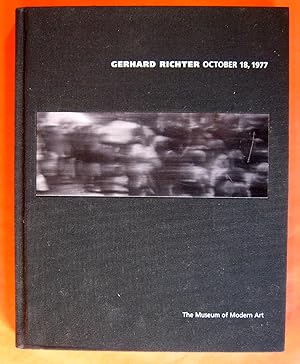A Museum of Modern Art Book
Gerhard Richter (b. 1932) is one of the most highly regarded of contemporary artists, and his series of 15 paintings known as October 18, 1977, is one of the 20th century's most famous works on a political theme. It commemorates the day on which three young German radicals, members of the militant Baader-Meinhof group, were found dead in a Stuttgart prison; they were pronounced suicides, but many people suspected that they had been murdered. Richter's paintings, created 11 years after this traumatic event, are among the most challenging works of the artist's career.
These hauntingly powerful images, derived from newspaper and police photography, are now in the collection of the Museum of Modern Art, New York, and will be on view beginning in September 2000 as part of the MoMA2000 series of exhibitions. In this book, Robert Storr provides necessary political background to the series, but his approach is art historical, offering insight into the complexities of "history painting" in the modern era.
ROBERT STORR is curator in the Museum of Modern Art's Department of Painting and Sculpture. His previous books, also available from Abrams, include Modern Art Despite Modernism, Tony Smith, and Chuck Close.
85 illustrations, 65 in full color, 9 x 111/2"
Destined to rank among the most eloquent and thorough examinations of a major suite of paintings,
Gerhard Richter: October 18, 1977 combines a lean, persuasively argued text with an elegantly sober design suited to the subject matter. Richter's 15 black-and-white paintings commemorate the day two leaders of the radical German Baader-Meinhof group, disillusioned men and women in their 30s and early 40s whose loyalty to the dogma of the Red Army Faction had led them to commit numerous terrorist acts, were found dead in their prison cells. Gudrun Ensslin appeared to have hung herself. Andreas Baader had been fatally shot. Jan-Carl Raspe was near death from a bullet wound. Two other members of the group had died in prison earlier in the '70s: Holger Meins after a hunger strike; Ulrike Menihof, by hanging. On the Left, there was widespread suspicion the dead had been murdered. Photographs of the Baader-Meinhof members were ubiquitous in newspapers of the day; their images were as familiar to Germans as machine gun-toting Patty "Tania" Hearst was to Americans. Using photographs as models, Richter painted the dead with a subtle technique--a blurring of certain details and an elegiac use of gray--that calls into question the murkiness of historical "knowledge" and emphasizes the uneasy mixture of compassion and horror evoked by the group's fate.
Yet, even though Richter waited until 1988 to paint the series, he was denounced either for glorifying a bunch of killers or for using his international fame to exploit the Left. Author Robert Storr, a curator at MoMA, which now owns the series, answers these arguments by looking systematically at postwar German politics, the tradition of history painting, and the dilemmas and decisions of a leading contemporary painter. --Cathy Curtis



